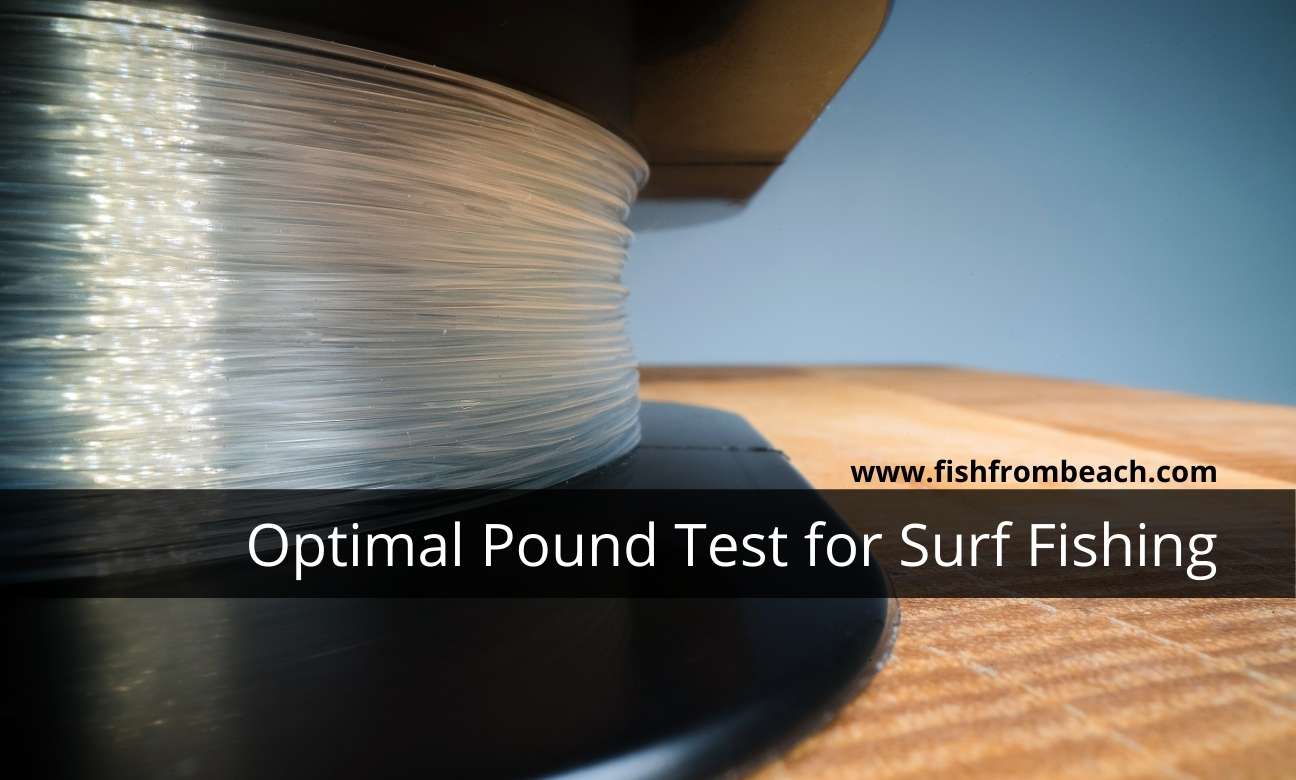The pound test of your line is among the main things to consider before surf fishing.
Think about it this way.
Your line is what connects you to the surf, and when a strike happens, the line is your most important tool to fight the fish and drag it to shore.
Your role as a surf angler is, therefore, to ensure that this connection remains safe and optimal at all times and keep out all situations and external factors that could potentially break it. Failing to do so puts your terminal tackle at risk and increases the likelihood of your line getting cut or spooled out.
This could lead to the loss of valuable trophies and expensive items, as your line might not have what it takes to withstand the fishing conditions you’re facing.
That’s where the pound test comes into play. The pound test is the way we measure and refer to the breaking strength of a fishing line. In other words, the pound test is the amount of pressure a fishing line can take before it breaks.
For instance, a 6 lb test line won’t break until 6 pounds of stress is exerted on it. Anything less will do great and keep the line safe.
Therefore, before you head to the beach for surf fishing, make sure the line you plan to use has enough pound test for your objectives and fishing conditions.
Many factors and variables dictate the optimal pound test to use from shore: the species you target, the weather and surf conditions, the structures you fish, your reel size, your line type, and more.
That’s what we will go through today.
In this article, we will dive deeper into this subject and discuss everything you should know when choosing the breaking strength of your surf fishing line.
As a general rule, the best pound test for surf fishing ranges between 15 and 20 lbs when using monofilament, and between 30 and 40 lbs when using braided lines.

What dictates your pound test when surf fishing?
Before we discover the best pound test for surf fishing, we will initially examine all the variables to consider when choosing the line’s strength.
Your setup
Your choice of how to configure your terminal gear is the main factor to consider when selecting a pound test. Are you planning to attach a shock leader to your line? Will you tie a short leader at the end? If so, how strong will it be? Is the sinker the last thing you plan to connect, or do you want to keep the hook last?
These choices dictate a lot about your surf fishing line weight. For example, if you choose to go without a shock leader then your line must be strong. In other words, the use of a shock leader allows you to opt for a small pound test.
Likewise, when fishing rough grounds and abrasive structures, connecting a strong, thick leader allows you to keep the pound test low. Otherwise, you should use a thick line in order to prevent cut-offs.
So the line size when surf fishing depends strongly on your rig and line configuration. This will be discussed in more depth later on.
The targeted species
The fish you target is another important factor to consider when deciding on the pound test.
The rule here is simple: The larger the fish you are chasing, the more pound test you need.
Generally, most species we catch from shore weigh less than 10 pounds. So for most cases, any line within the range of 10-20 lb test will perform great in the surf. In addition, this range when associated with experience and enough line on the spool, may be enough to land much heavier predators.
Another way targeted fish can affect the pound test is whether or not they have sharp teeth. Species like bluefish, mackerel, or the red snapper have sharp sets of teeth and therefore require the use of thick, abrasion-resistant lines.
Here, if you want to maintain a thin line while targeting toothed fish, you can attach a strong, thick leader at the end of your line (before the hook) to offer the required protection against sharp teeth.
Learn how to choose your leaders when surf fishing.
The fished structures
Seabeds rich in rocks and boulders require the use of strong and thick lines in order to reduce the risk of cut-offs. A higher pound test means a bigger line diameter and thus a better resistance to abrasive structures.
Similarly, if you want to keep the main line thin when fishing rough grounds, you can add a strong leader at the end to withstand the abrasion.
Your casting weight
During casts, your sinker exerts significant pressure on the line, and if the line isn’t sufficiently strong, it might snap, causing the sinker and hook to fly through the air.
This could result in the loss of many expensive items and also put your life and that of others in danger.
Therefore, it’s crucial to have enough pound test to absorb the stress you create when performing powerful casts.
As a rule of thumb, you should use at least 10 pounds of line weight for every ounce you cast. And that includes both the sinker and the bait.
For example, if you are using a 4-oz sinker with a 1-oz piece of bait, then the minimum pound test of your line should be 50 lb.
If you don’t want to go that heavy, then at least connect a 27-30 feet shock leader (preferably monofilament) of 50 lb test at the end of your line and you should be good to go.
Read this article for more information about surf fishing shock leaders.
The weather and surf conditions
Thick lines are less stable when fishing heavy currents and when a strong wind is blowing off.
In such conditions, a high-diameter line receives more pressure from the current and the wind, thus getting pulled out of the strike zone quite easily.
Fish only hold where they have easy access to food and where they can hide safely from larger predators. As a result, they usually concentrate on specific areas in the surf zone. What does this mean? It means that when surf fishing, you need to be picky in terms of where to deploy the bait and also worried whether your offering will stay where it should or not.
That’s why it is recommended to use a thin line during choppy weather and surf conditions, as it helps to stay where you are most likely to have bites.
Read more tips on how to fish the surf during strong currents.
The type of line
The type of line is another factor to consider when optimizing your surf fishing pound test.
Braided lines provide high breaking strains while keeping the diameter low. As you can see below, an 80 lb test braided line is as thick as an 18 lb test monofilament line. This is an enormous advantage when fishing an agitated surf because you will have enough pound test to control sizeable fish without worrying about the stability of your terminal tackle.
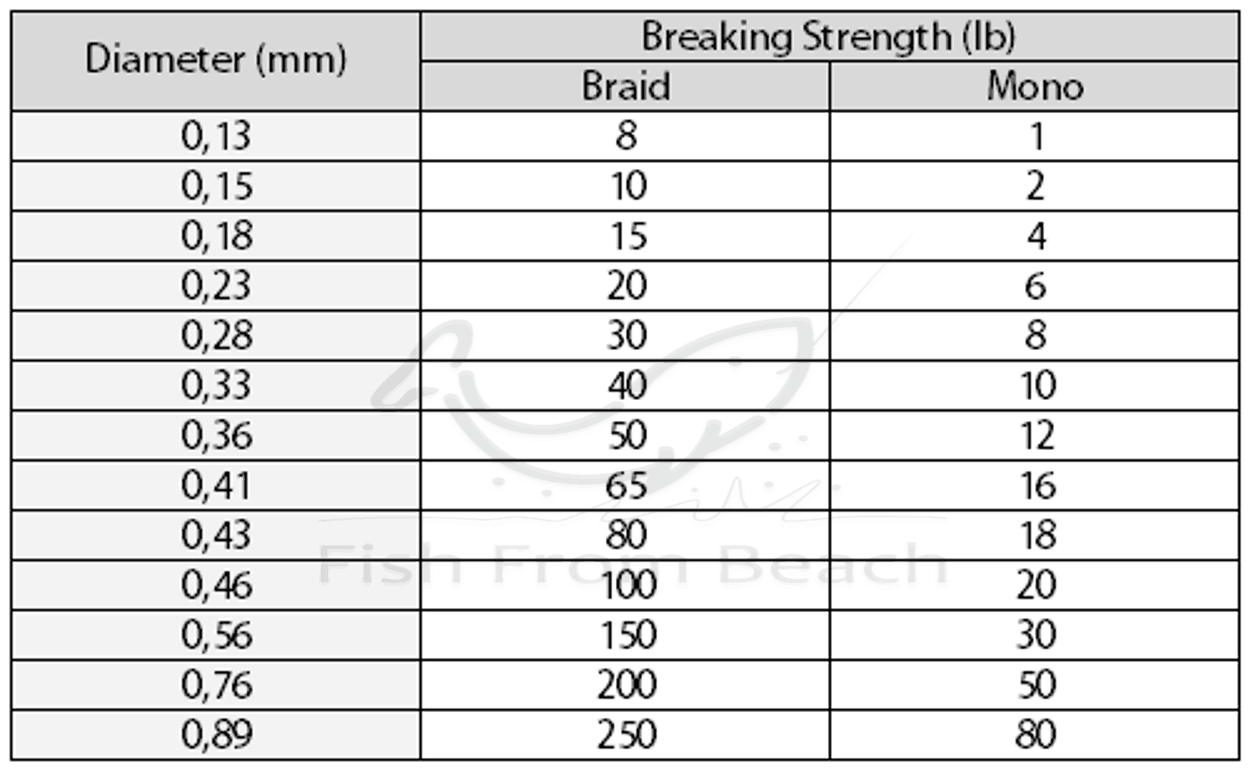
That said, It is worth noting that braid is a terrible abrasion-resistant, and that makes it a poor choice when fishing rough grounds.
On the flip side, nylon monofilament and fluorocarbon are thicker and do not provide the same breaking strength as braid. This is why it is recommended to stick to braid when targeting sharks and other large predators from shore.
However, mono and fluoro perform better when exposed to abrasion. This makes them the way to go when fishing rocky waters, and also when targeting fish with sharp teeth.
In addition, mono and fluorocarbon stretch more than braid. As a result, they serve as a better safety cushion when the pressure goes so high.
Read this post for more about the battle between mono and braid from a surf fishing perspective.
Your reel
The size of your reel is an important factor to consider when picking the weight of your line. Large spools allow the use of thick lines with a higher pound test. Conversely, small reels force low breaking strains in order to fit enough line on the spool.
When surf fishing, you need around 250-300 yards of line in your reel. Therefore, your pound test should allow you to have this amount on whatever reel you use.
Your experience
The more experience you have, the lower the pound test you need.
I was fortunate to witness many surf anglers successfully landing monstrous fish (over 40 lb) with very light lines (less than 15 lb test). How do they do that? Well, they have skills…
They know how to manage their limited resource (the weak line) during the battles and this includes:
- How and when to retrieve the line?
- When to palm the spool?
- How to work the rod during the different phases of the fight?
- When to tighten the drag and when to let the fish run?
- When to move around along the shoreline during fights, and when to stand still in one particular spot.
All of these are skills that can be taught, but they are only truly mastered after years and years of trial and error.
In our ebook “101 tips for surf fishing”, we meticulously crafted some invaluable tips and insights on how to fight and land fish off the beach. The ebook is guaranteed to spare you 2-3 years of experimentation and a lot of lost trophies and heart-wrenching moments.
What’s wrong with a low pound test?
A low pound test forces you to use a low drag
Before we talk about this, I presume you’re already familiar with the concept of drag in fishing. If not, I strongly encourage you to check out our previous post where we comprehensively covered everything about drag and its importance in surf fishing. For those short on time, here’s a brief definition:
The drag refers to a mechanism inside the reel that allows the line to be pulled out when a fish pulls on it. It’s like a controlled resistance that prevents the fish from breaking the line while swimming away. The drag system also helps you tire out the fish and reel it in successfully.
Now, let’s continue what we were saying.
There is a common misconception in fishing that a low pound test means a higher risk of line cut-offs. They think that because the line is weak, it will snap easily if a heavy fish takes the bait.
Well, it’s more complicated than that.
Remember that you have a reel with a drag system that releases the line when subject to pressure. In consequence, when a heavy fish strikes your offering and runs with it, the line may not necessarily break; rather, it could simply leave the spool and allow the fish to go farther.
Fish can only break your line if you set the drag system above the actual pound test of your line.
Repeat the previous sentence once again.
In this scenario, if a fish weighing between your pound test and your drag setting hits the bait, then the line will receive stress that exceeds its capacity before the reel starts to release the line. In this case, yes, the line will break, but in any other scenario, it will remain just fine.
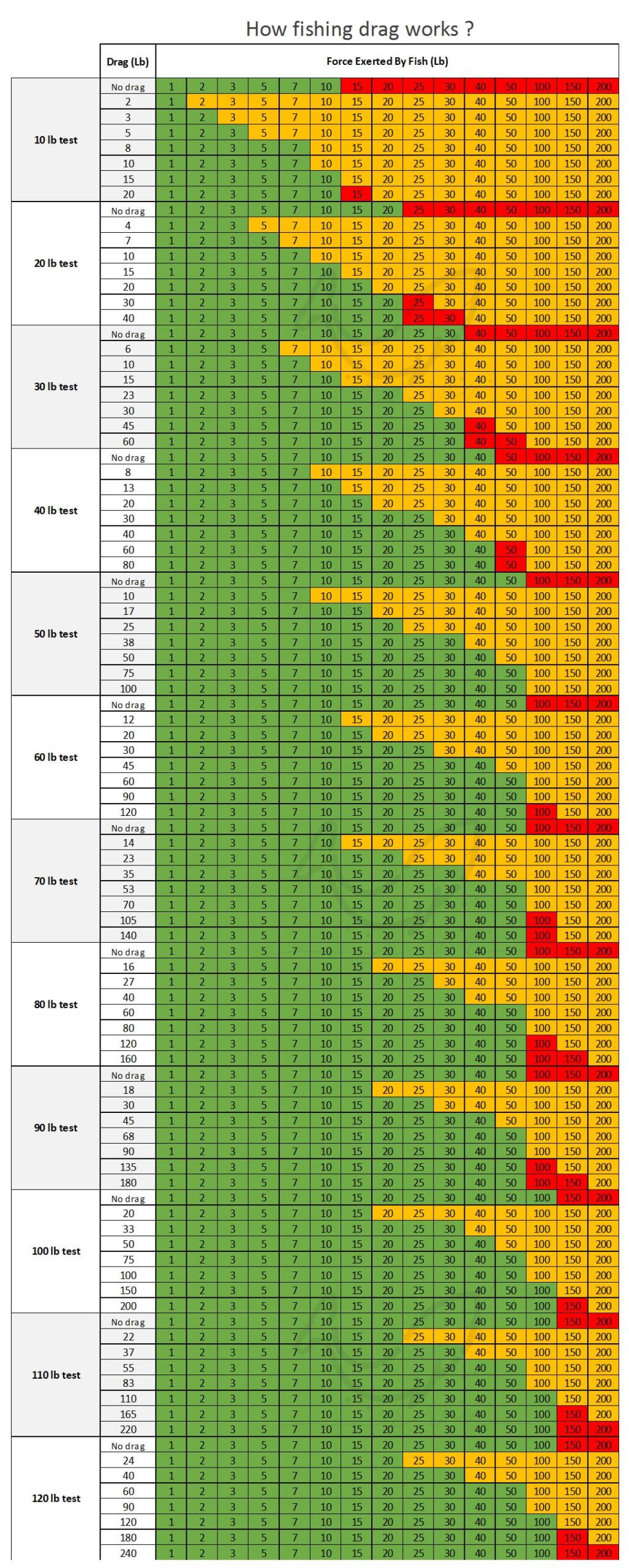
As you can see in the table above, your line will only snap (red squares) if you set the drag to a value that exceeds your actual pound test. Otherwise, it will stay on the spool (green) or follow the fish as it runs (yellow).
And that’s the problem behind a low pound test.
As the line can only break if your drag is higher than your line’s weight, you are, therefore, forced to set the drag very low when using a low pound test.
As a rule of thumb, the recommended setting for the drag is 1/3 of your line’s weight. So, for example, if you plan to use a 6 lb test line, then you should set the drag to 2 pounds. 2 lb of drag is generally pretty low for surf fishing. Why? Simply because many fish species that live nearshore exceed that weight and will be able to pull your line.
Generally speaking, this should not be a source of concern when the difference is small. In other words, it is possible to catch a 15-20 pound fish with a 6 lb test line. Yes, it will be able to take a large amount of your line, but it’s likely that it will give in and get tired before you reach the end of the spool.
However, when things get so heavy, that’s where we should expect problems.
You don’t want a 50-pound striper to strike your bait when you have a 6 lb test line.
Yes, it’s doable (see the records here), but also very challenging.
With a high pound test line, you will be able to set a higher drag and therefore limit the release of the line during fights and have more control over fish.
For example, the recommended drag setting for a 20 lb test line is 6-7 pounds. This is more than the weight of most species we catch from shore, and even if a heavier monster takes the bait, your tight drag will help to tire it up faster without losing so much line.
So in summary, the problem with a low pound test is not a higher risk of line cut-off, but rather, more odds of losing the entire line when fighting a large fish.
It is very important to mention that in the previous paragraphs, I assumed that your rod is powerful and has decent lifting power and that you respect the recommended line size stated on the rod. Otherwise, and in case things get heavy, the rod might break before the line, which is a more unfortunate outcome. I invite you to read the article where we discussed everything you need to know about surf rods power.
A low pound test is not good against abrasion
The other setback of a low line weight is vulnerability to abrasion.
When fishing mixed seabeds, you need your line to be thick in order to survive sharp rock piles and boulders.
For a given line, a lower breaking strength generally means a lower line diameter. This can be a terrible choice when fishing abrasive structures, as the line will run a higher risk of snapping if rubbed against sharp objects.
The same goes when targeting sharks and other sharp-toothed fish. Such species can easily bite through your line when striking your bait and therefore require thicker/stronger lines.
What’s wrong with a high pound test?
A higher pound test line allows setting a tighter drag and therefore helps to turn larger fish. But does this mean we should pick the highest pound test we find in the tackle store? Of course not, this would be so counterproductive.
While a thicker line gives more control and leverage when fighting fish, it also raises several disadvantages that can reduce your catch count.
First, for a given line type (braid, mono, or fluoro), a thicker line is a stronger line, and as a result, a more expensive line, obviously 😀
Second, a thicker line receives more pressure from currents and tidal movements, which makes it less stable in the surf, especially during choppy surf conditions.
Third and similarly, a line with a higher diameter receives more friction from the air during casts and therefore reaches a shorter distance in the surf.
Moreover, a thicker line is more affected by the wind and therefore makes it harder for your bait to stay where you want it to be.
On top of that, you can only fit a small amount of line on a reel when it’s thick. This obviously hurts the casting distance as you will be left with fewer yards of line on the spool.
All of these drawbacks restrict our freedom to choose higher pound tests.
I mean, yes, a stronger line is more effective at landing fish and more resistant to abrasion, but it can also hurt our casting distance and stability in the surf and, as a result, hurt our overall productivity.
So we are in a trade-off situation here: Both high and low pound tests have benefits and pitfalls.
We must therefore consider all the factors that dictate the optimal pound test for surf fishing before picking the one that suits our conditions and objectives.
What pound test to use in the surf?
After all the theoretical things we talked about in this article, now comes the moment to answer the big QUESTION: what pound test is best for surf fishing ?
Well, there is no line weight that works perfectly for all conditions and all scenarios. Therefore, I will give the answer for different scenarios based on my experience, that of my friends, and what I found on the web.
For each case, I will also include how to choose the shock leader and leader, if necessary.
For open waters
The main line: 15-20 lb monofilament or 30-40 lb braid. I prefer braid, but I would pick mono if I’m still learning. Monofilament allows you to make mistakes during battles without facing severe consequences.
The shock leader: 50-80 lb monofilament, depending on my sinker. As said before, the rule for the shock leader is 1 pound for every ounce you cast.
The leader: 15-20 lb monofilament or fluorocarbon. Fluorocarbon is less visible than monofilament but more expensive. Here, remember to use a thicker leader if toothed fish are around.
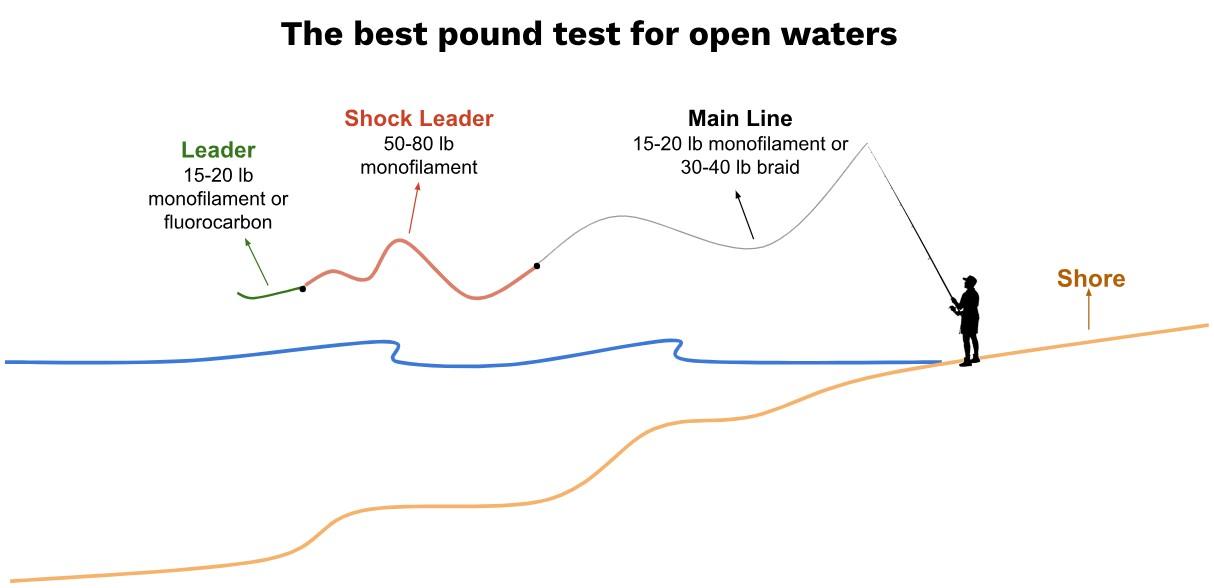
For rough grounds
The main line: 15-20 lb monofilament or 30-40 lb braid.
The shock leader: 50-80 lb monofilament, depending on my sinker. Here, besides absorbing the pressure during casts, the shock leader will also help to cope with the abrasive structures.
The leader: 20-30 lb monofilament or fluorocarbon. Keep the leader thick because it will be in contact with rocks.
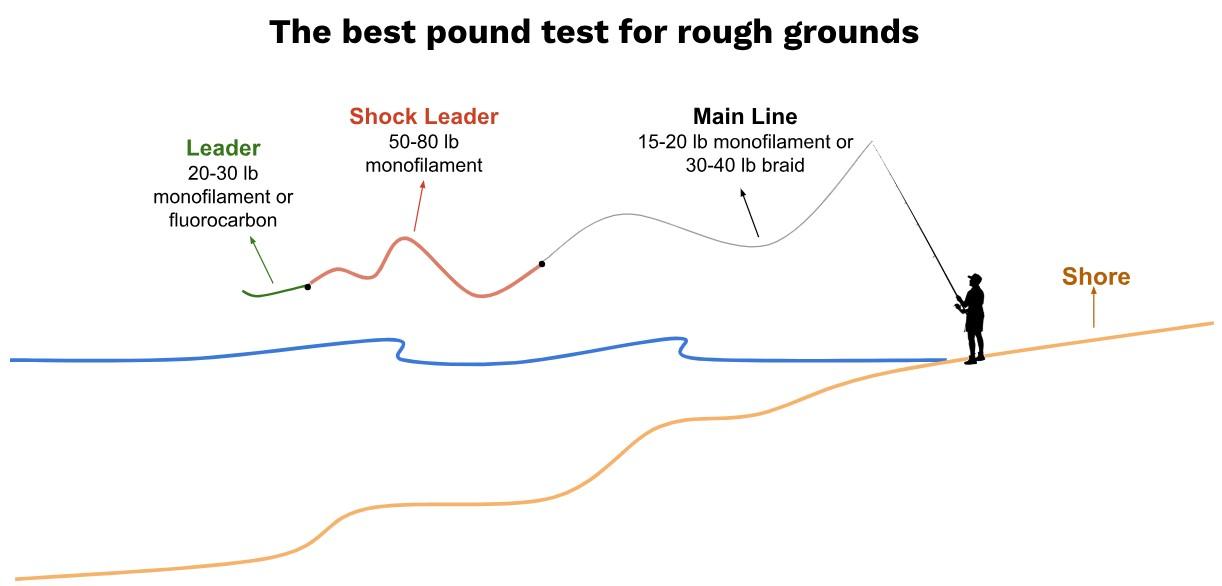
For strong currents or windy weather
The main line: 50-80 lb braid. Braid will keep the diameter low to cast farther and withstand strong winds and currents.
The shock leader: No need for a shock leader. You need to keep the diameter low when dealing with strong currents and winds. So a straight braided line will do the job here.
The leader: Similarly, keep the diameter thin. 15-20 lb monofilament or fluorocarbon is the way to go here.
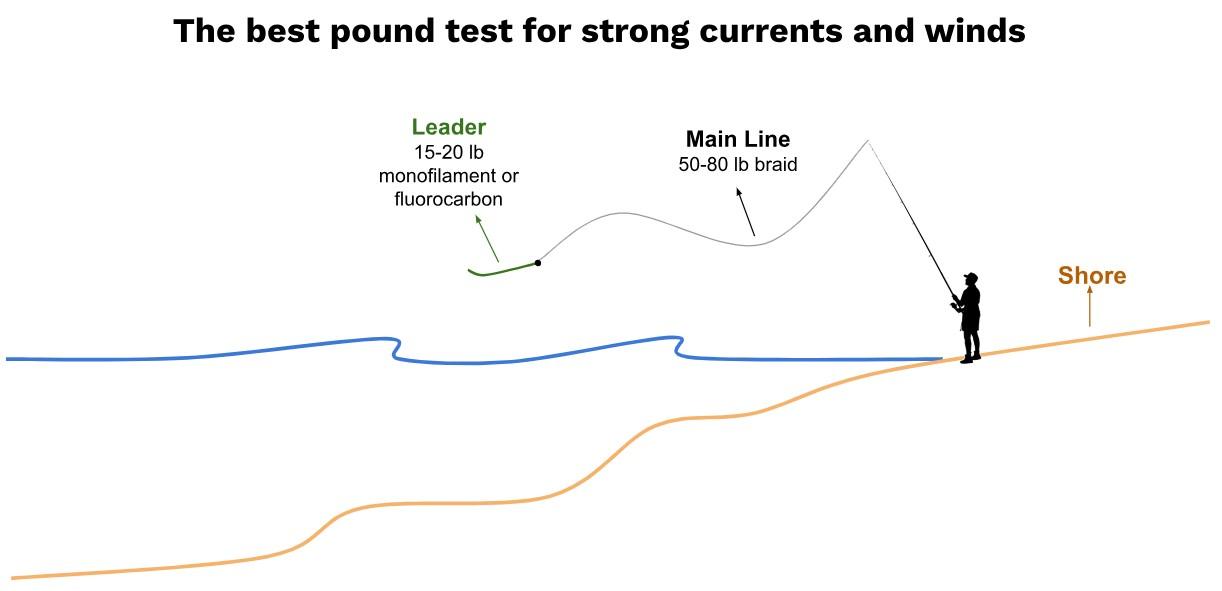
For monstrous fish (sharks, tarpon, tuna…)
The main line: 80-100 lb braid. I would not think of mono when targeting monstrous fish as it will significantly affect my casting distance and my stability in the surf zone.
The shock leader: Same as above, no need for a shock leader here.
The leader: 80-100 lb monofilament or fluorocarbon. Steel leaders can also be a good choice, especially when targeting sharks.
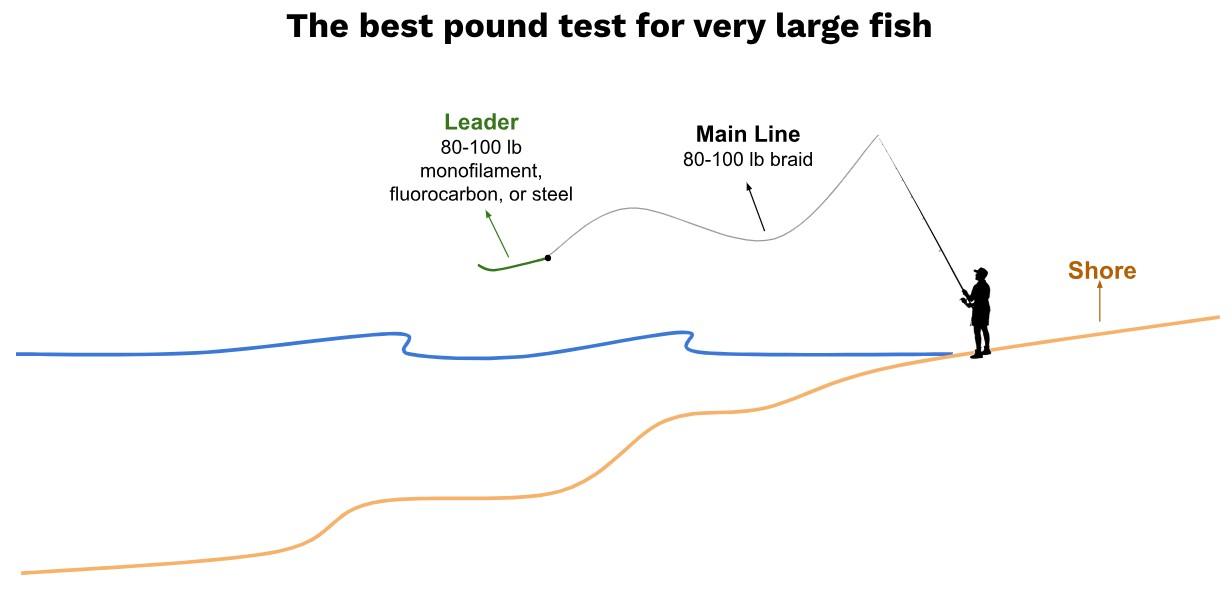
For large fish (bluefish, redfish, striped bass…)
The main line: 50-80 lb test braid. Similarly, I would stick to braided lines when targeting heavy predators.
The shock leader: Same as above, no need for a shock leader here.
The leader: 30-50 lb monofilament or fluorocarbon.
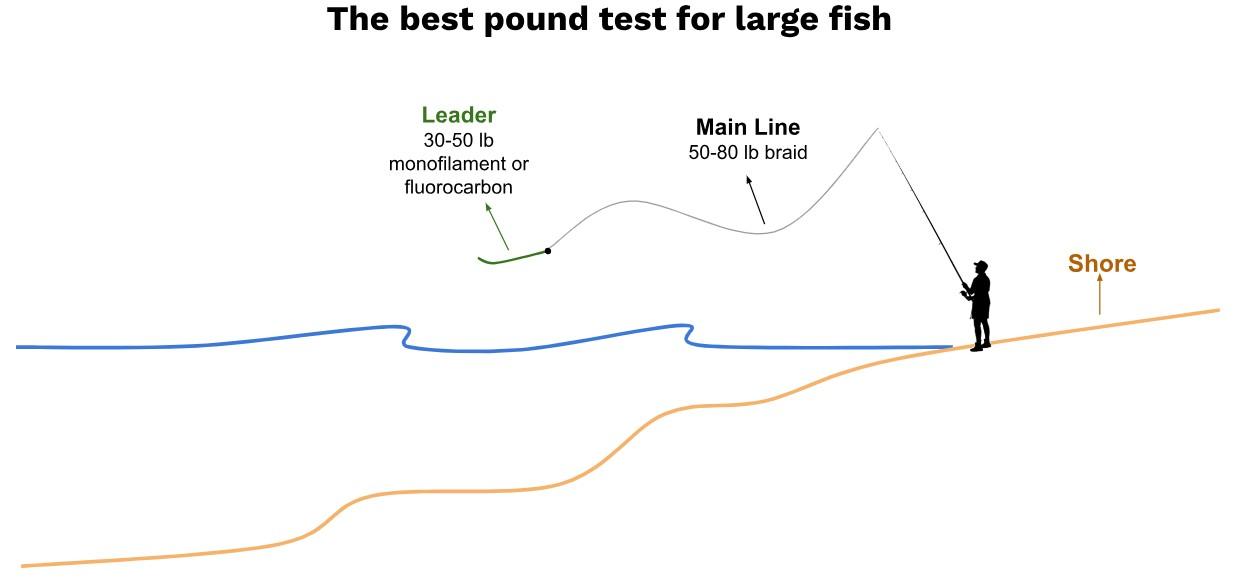
For medium-sized fish (pompano, trout, snapper…)
The main line: 15-20 lb mono or 30-40 lb braid depending on the structures and surf conditions.
The shock leader: 50-80 lb monofilament, depending on my sinker.
The leader: Monofilament or fluorocarbon. The strength depends on the structures and targeted species. For instance, the red snapper has sharp teeth and thus requires a strong leader.
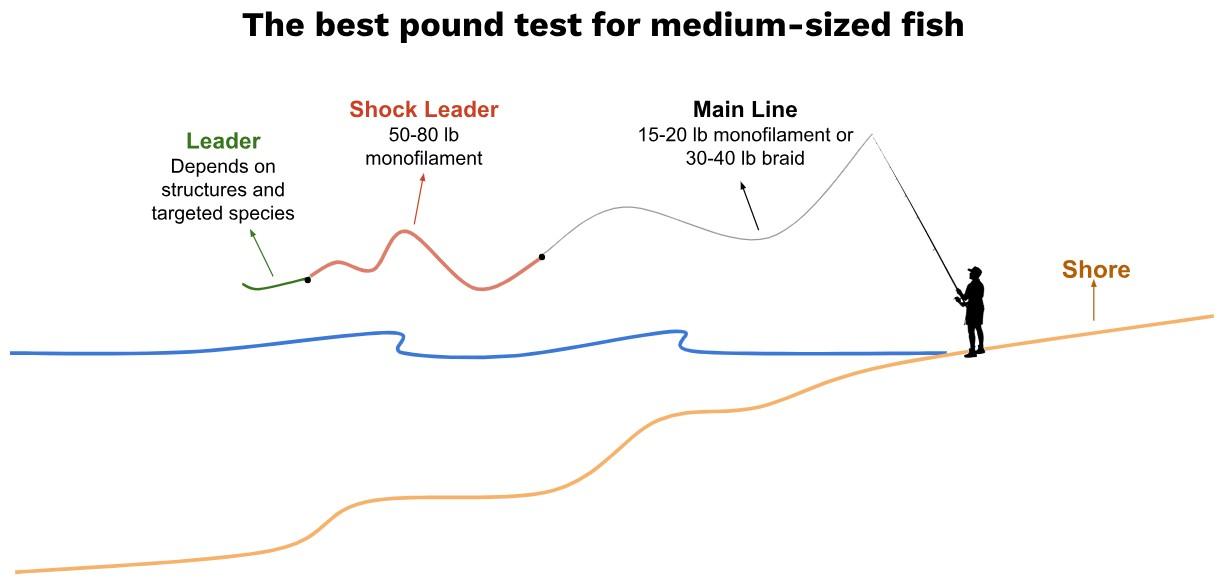
For small-sized fish (bream, perch, flounder…)
The main line: 8-15 lb mono or 20-30 lb braid depending on the structures and surf conditions. I believe 8 lb test is the minimum pound test for surf fishing. Anything less would put your gear at high risk.
The shock leader: 50-80 lb monofilament.
The leader: Monofilament or fluorocarbon. The strength depends on structures and targeted fish.
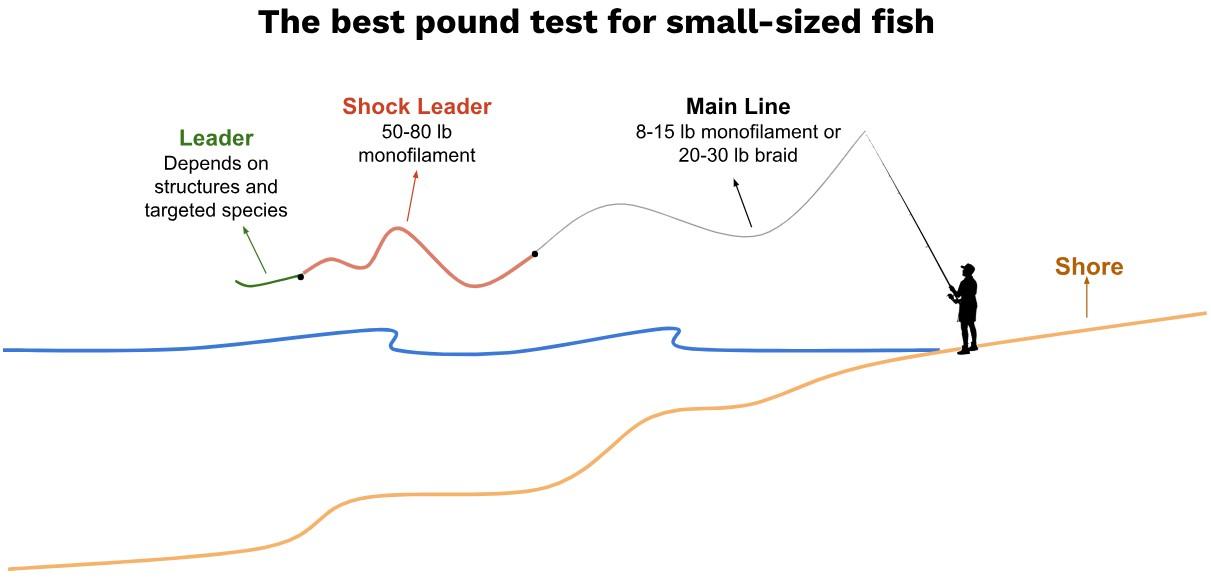

The answer
So, as you can see, every situation requires a different setup, strength, and thickness.
What works great for me is probably a terrible choice for you.
So before you decide on the pound test of your surf fishing line, you need to do the homework first and consider all the factors that characterize your fishing conditions and objectives.
This is the only way to find what works best for you.
With that being said, remember that when surf fishing, you cannot anticipate what might take your bait. Once it’s in the water, you’re inviting a variety of fish to your offer. Consequently, your line must have the necessary strength to handle even the heaviest surprises.
Moreover, it’s challenging to predict when the current and wind might intensify. Therefore, it’s important to have a line that can withstand unstable surf conditions, allowing you to remain stable where you believe most fish hold.
This is why I believe 30-40 lb braid is the optimal pound test for surf fishing. This size is stronger than most fish living nearshore and at the same time sufficient to turn heavier fish effectively.
Also, a 40 lb braided line has the same diameter as a 10 lb monofilament line, making it a great option for heavy-current fishing.
However, when fishing rough grounds, braid may be a bad choice because of its vulnerability to abrasion. In this scenario, a 15-20 lb monofilament will do great with most fish while keeping your line safe.
So summarizing, the all-around best pound test for surf fishing is 30-40 lb when using braid and 15-20 lb when using monofilament.
These sizes are most likely to perform well, regardless of your experience level and your fishing conditions.
When we asked our readers about their favorite pound test when surf fishing, the answers varied. Among 825 respondents, the most commonly chosen line weight for surf fishing was the 20-30 lbs range, selected by 34.67% of participants.
Following closely behind was the 15-20 lbs range, favored by 26.30% of respondents. Other pound test preferences included 30-40 lbs (12.73%), 10-15 lbs (9.58%), and 40-60 lbs (8.73%).
Line weights above 60 lbs or below 10 lbs received relatively lower preference.
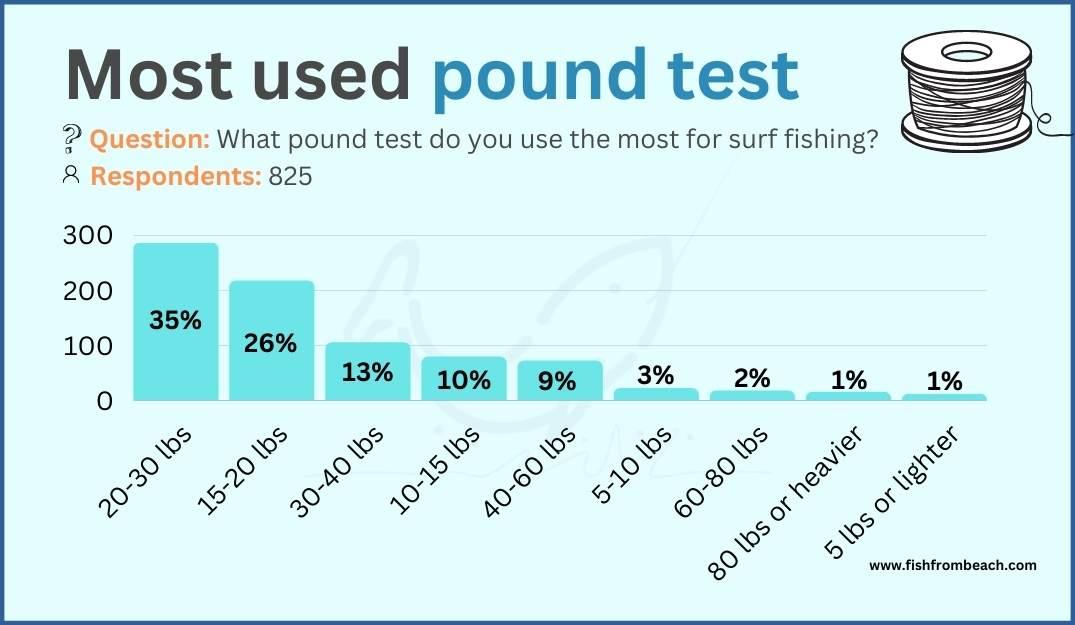
My line recommendations*
When it comes to the line, I only use 2 products for surf fishing:
1- The Berkley Trilene Big Game Monofilament
The first product is the “Berkley Trilene Big Game“. This is my ultimate preferred option when opting for monofilament, whether for my shock leaders, main lines, or even my end leaders. It comes in different colors and offers more than 20+ different pound tests. I like to keep 4-5 spools from this product covering different strength categories within the 10-30 lbs, 50-80 lbs, and 80-100 lbs ranges.
One thing I particularly like about this product is the low memory. Compared to other monofilament lines I used, this one tends to take more time to adopt that annoying coiled shape.
2- The KastKing SuperPower Braid
I’ve tried numerous products for the braid, but none have proven superior to “The KastKing SuperPower“.
This is coming from a historically braid lover. When it comes to resistance to abrasion (which is the main disadvantage of braided lines), durability, and knot strength, I believe this one has no concurrence in the market. And of course, it’s ultra sensitive and strong.
You have a wide spectrum of choices when selecting this product. For me, I have two reels filled with this line; one with the X4-Ocean Blue option, pound test of 80 lbs. The second with the X4-Yellow option, pound test of 40 lbs.
Learn how to choose your surf fishing line color.
How to compensate for a low pound test?
As previously mentioned, the main issue associated with using a low pound test line is the risk of being spooled out. Now, while this is quite infrequent, it’s important to be ready for a scenario where your 8 lb test line is challenged by a 40 lb redfish.
The thing here is that you can’t predict the behavior of fish once they’re hooked. Some will do non-stop sprints until they spool you out. Some will execute brief, consecutive runs. And some will simply yield, enabling you to smoothly draw them to the shoreline.
One thing to keep in mind is that consistently using a low pound test will inevitably lead to a situation where a fish takes your entire line. I mean, regardless of your expertise or skill in maneuvering fish, if you consistently opt for a low pound test, this will happen one day.
That being said, there are a few tips that you can try if you want to reduce the risk :
- Use a larger spool (6000 or more) to fit more line into your reel.
- Use a softer rod (medium action) in order to absorb the runs of fish and reduce the release of line.
- When you feel the fish is about to run or jump, quickly head the rod’s tip seawards to absorb the shock.
- You can also palm the spool to limit the release of line when the fish is running.
- Know when and at which speed you need to retrieve the line. After a long run, retrieve fast and gain as much line as you can. Apart from that, reel in extremely slow and avoid any sharp or abrupt motion that can provoke the fish and make it run again.
- And the most important tip is: Be Patient. The fish is stronger and faster than you, so don’t try to force it to shore. It will defeat you. Instead, be patient and wait until it gets tired and becomes weaker, slower, and easier to control.
It is a war of attrition where the winner is the one who lasts more. Not the stronger and not the faster, but the one who stays longer in the fight.
Generally speaking, if you survive the first runs of the battle, you can comfortably assume that you’ve secured the catch. However, you need to stay calm and patient the entire fight. You don’t know when the fish may strike again.
We’ve dived deeper into such tips in our ebook “101 Tips for Surf Fishing.” The information and insights provided within are certain to answer all your questions and spare you a lot of research and experimentation. So be sure to give it a look.
How to compensate for a high pound test ?
Besides the cost, the only pitfall of a powerful line is the thickness which makes it unstable when subject to heavy currents and strong winds.
This prevents your bait from staying where the fish are most likely to feed and therefore reduces your bite count.
Therefore, a thick line should always be associated with a heavy casting weight. Anything between 4 and 8 ounces will do great and keep your baited rig where it should be.
Pyramid and spider sinkers are the best options here. These leads are designed to provide a better grip at the bottom and resist better to moving waters.
However, keep in mind that increasing the weight hurts your sensitivity and ability to detect bites. Why? Because it will require a sizeable fish to hit your bait in order for you to feel something. Small fish with subtle tugs won’t be able to move your heavy rig a lot.
More about bite detection here.
Also, remember that your rod can only support a certain amount of casting weight. Going over this limit could break the rod or cause permanent damage. So make sure to respect the recommendations of your rod manufacturer.
On top of that, heavy leads cause more fatigue to your arms, wrists, and shoulders. This can make you go home sooner and miss better fishing opportunities.
Another way to compensate for a too strong line is to use braid instead of mono or fluoro. As mentioned earlier, braid provides a higher pound test while keeping the line thin. So for a given pound test, a braided line will withstand better to currents and winds.
Read this article for more information on the best time to use braid from shore.
Another disadvantage of thick lines is the limited casting distance. The high diameter makes the line receive more friction from the air during casts, which slows it down and makes it drop sooner into water.
The use of a larger spool that can hold more line, along with minimalistic rigs such as the fish finder rig or the Carolina rig may help to reach more distance.
The pulley rig is another good line setup if you want to maximize your casting distance with a thick line, especially when fishing rocky grounds.
Note (*): If you make a purchase through links from this website, we may get a small share of the sale from Amazon or other similar affiliate programs.
Surf Fishing Survey
Help us provide you with better content by answering simple questions about your surf fishing experience and knowledge.
We will put the collected responses together and turn them into valuable information that will help you catch more fish from shore 😉
Note: No personal information will be collected with your answer.

